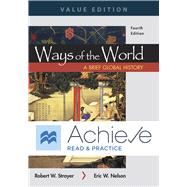Ways of the World is one of the most successful and innovative textbooks for world history. It includes a brief-by-design narrative that focuses on significant historical developments and broad themes in world history. With keen consideration of the needs of their student audience, authors Robert W. Strayer and Eric W. Nelson provide an insightful, big picture synthesis that helps students discern what matters most in world history--patterns and variations on both global and regional levels and continuity and change over time.
Available for free when packaged with the print book, the popular digital assignment options for this text bring skill building and assessment to a highly effective level. The active learning options come in LaunchPad, which combines an accessible e-book with LearningCurve, an adaptive and automatically graded learning tool that—when assigned—helps ensure students read the book; the complete companion reader with Thinking through Sources digital exercises that help students build arguments from those sources; and many other study and assessment tools. For instructors who want the easiest and most affordable way to ensure students come to class prepared, Achieve Read & Practice pairs LearningCurve adaptive quizzing and our mobile, accessible Value Edition e-book, in one easy-to-use product.








